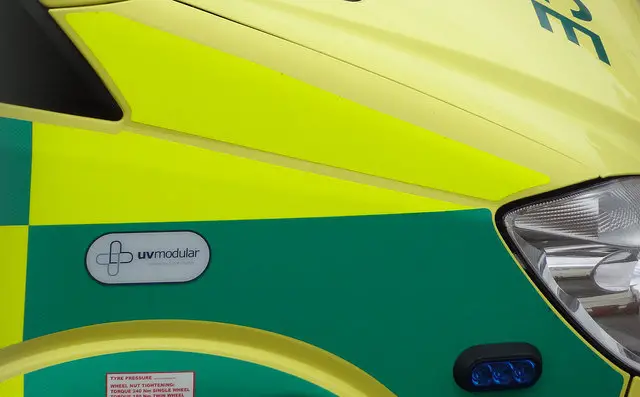Being attacked by a drunk teenager and threatened with a lit cigarette are just some of the incidents Isle of Wight paramedics face on a daily basis.
Following a spike in assaults by members of the public, ambulance staff have spoken about the physical and verbal abuse they experience on the job — something they say is quite commonplace.
Tougher sentences for offenders
New rules introducing tougher sentences for anyone convicted of assaulting an emergency service working became law yesterday (Thursday).
The Assaults on Emergency Workers (Offences) Bill received Royal Assent will come into force in November.
Real life stories
Matt, Sarah and Jenny have been working for the Isle of Wight ambulance service for a combined 56 years. They began working in patient transport before being transferred to the front-line.
Jenny, who used to teach middle school children, began work straight on the front-line.
Matt said:
“We’ve been sworn at so many times, you almost stop hearing it.”
Drunken 14 year old
Last month, Matt was called to attend an incident with a drunken 14-year-old girl at the bottom of Newport.
He said by the time they had reached the end of the dual carriageway, the teenager had climbed up and out of her seat and begun to throw punches at him.
He said,
“When we arrived at A&E I had to call for a female member of staff to assist me getting her out of the ambulance — she fell out of the vehicle.”
CCTV recordings
All ambulances are equipped with 360 CCTV inside (with colour and sound) and outside (just images).
When a patient begins to get aggressive, staff can press a button to begin storing the footage, in part to protect them from any potential lawsuits.
Situations can turn dangerous quickly
When the ambulance hub receive a call, they often get the bare minimum information, and a call can quickly turn dangerous once they arrive on the scene.
Sarah once responded to a suspected elderly lady with breathing difficulties. She said,
“Sometimes you just get a gut feeling when you go to a job, and you know something is wrong.”
When she opened the door, instead of an elderly lady, she saw a young man with a backpack crouched, hidden out of sight.
She said,
“I said ‘Someone will be with you soon’, and immediately slammed the door shut and had to drive down the road — it was obviously a case of someone with complex mental health issues, but it really knocked me.”
Unexpected aggression
Sarah said the hardest part was when a patient suddenly turned and became aggressive without warning.
In one incident, after taking a woman to A&E, she tried to reclaim the gas and air canister from them. She said,
“She went berserk in the cubicle. She had backed me into a corner and my colleague had to use his specialist training to restrain her. I was really scared.”
The patient had been completely fine in the ambulance, chatting about family and friends, but Sarah realised after she was addicted to the pain relief.
Consequences of drug abuse
Drug abuse is something the team experience on a regular basis — attending up to four overdoses a fortnight.
Matt said,
“When you get them to A&E they become aggressive because you’ve ruined their high.”
Aggression from family members
With a high volume of calls being put through to the ambulance teams, long wait times for non-emergency calls can mean when the paramedics arrive on scene, family members start to vent their frustrations at them.
The new national standards mean category one (life-threatening) calls have an average response time of seven minutes. Category two (potentially serious conditions) have an average wait of 18 minutes. Category three (urgent but not life threatening) has a maximum response time of 120 minutes. The final category (category four) for non-urgent calls has a maximum response time of 180 minutes.
Putting my ‘mum’ hat on
Sarah said,
“I went out to help one young lad who had a nasty break. He swore at me when I arrived, so I put my ‘mum’ hat on. By the time we’d reached the hospital he was holding my hand because he didn’t want to be alone.
“I’ve had bruises from elderly ladies, but that’s part of the job. But some people do know what they’re doing.”
Mental health crisis
Often the crews visit incidents involving mental health — which can take up to two hours to resolve — and they say it feels like they are being used to plug gaps in the lack of support services on the Island.
“People think ‘just send the ambulance’.
“We may have about 15 vehicles, but it’s usually the same six — our most modern — running around the whole Island.”
The number of ambulances on at any one time fluctuates depending on demand.
Police cuts affect ambulance service
The crews can request back up, but with cuts to policing numbers this may not always arrive.
Jenny was called to an incident involving a man with mental health problems. They had requested a police presence, which did not arrive. After spending an hour getting him in the ambulance, it was decided she would travel in the back with him as the patient had taken a shine to her.
She said:
“You have to do what’s in the best interests of the patient.”
Sudden change in behaviour
As they neared the hospital, the man began to move around the truck and take his clothes off, before redressing. When they arrived and Jenny’s colleague went to open the back door, the patient shouted ‘Do not open that door’, trapping Jenny in the truck with him.
After being coaxed out of the vehicle, he lit a cigarette and began threatening her, holding the lit cigarette in her face, before running off back down the road.
She said,
“When he had gone, my colleague and I closed the doors to the truck and both burst into tears.
“I was scared, but scared because although I knew I could protect myself and I didn’t know what I’d do if he’d hurt me. I didn’t want to hurt him.”
Matt added:
“It’s hard to describe the emotions you feel. Angry, scared, guilty — did I do enough? Could I have done more to prevent the situation?”
High number of non-emergency calls
Service delivery manager, Darron Howard, said part of the problem was the high numbers of non-emergency calls.
He said:
“I don’t think the public realise how hard the job is. Yes, they may have been waiting a few hours but we will have been dealing with patients who are a lot sicker.”
Body-worn cameras pilot
Isle of Wight crews will be one of the first in the country to pilot body-worn cameras, to help assist in prosecutions in the case of assaults, something the teams say will make them feel safer on the job.
Jenny and Sarah have trained in trauma management and are able to spot if a member of the team is struggling.
Whereas previously they were able to debrief after calls over a cup of tea with colleagues, now the volume of incidents mean they are frequently sent straight out to the next job.
Automatic stand-down
An improvement has been the introduction of special training [called TRIM] providing support to staff who have experienced a difficult incident and the automatic ‘standing down’ of a crew following an incident.
Jenny said:
“We do really love our jobs, and the teams really support each other.
“It’s a real career — it’s a job you have for life.”
Younger staff leaving early
However, many younger paramedics are leaving the career early — statistics show 40 per cent left the industry within five years of graduating from university.
With assaults becoming commonplace, Darron said the teams were doing everything they could to retain staff on the Isle of Wight.
Zero tolerance policy
The Isle of Wight NHS Trust has a zero tolerance policy and will prosecute people who assault staff.
Matt said:
“There’s nothing quite like it — when you get a thank you from someone, or even see someone on the street who you’ve helped, you know you’ve made a difference.”
To find out more about careers in the Ambulance Service visit the NHS Careers Website. For more information about training to be a Paramedic visit the College of Paramedics website.
This article is from the BBC’s LDRS (Local Democracy Reporter Service) scheme, which OnTheWight is taking part in. Some additions by OnTheWight. Ed





